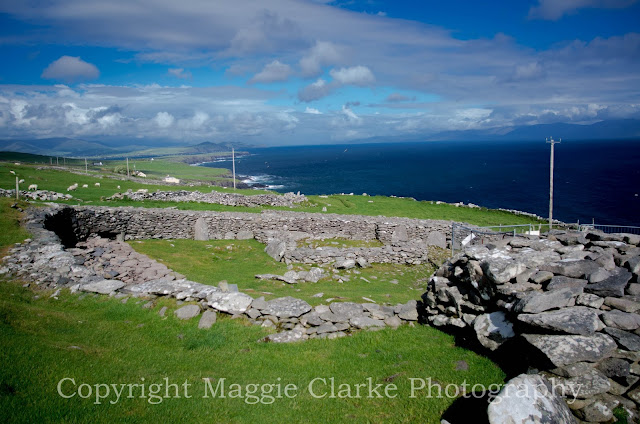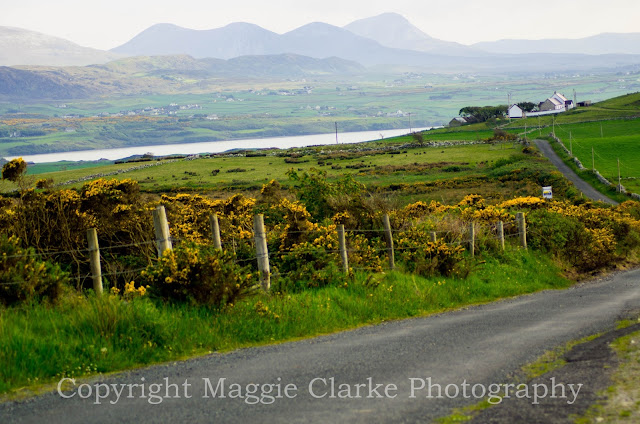June 14, Friday Killarney and Dingle
 Today was looking like
our weather luck was going to run out. It was raining at breakfast (which was not the
best on this trip) and also when we got to Muckross House and gardens, the Torc
waterfall (always a good subject for rainy days), and the Ross castle. We spent an hour and a half in the Muckross
grand house on tour, dozens of rooms, an intricate system of pull cords to
summon specific servants for specific masters and mistresses, and yet no
electricity until I think they said the 1960s. Looking at the clouds through the windows... impressive!
Today was looking like
our weather luck was going to run out. It was raining at breakfast (which was not the
best on this trip) and also when we got to Muckross House and gardens, the Torc
waterfall (always a good subject for rainy days), and the Ross castle. We spent an hour and a half in the Muckross
grand house on tour, dozens of rooms, an intricate system of pull cords to
summon specific servants for specific masters and mistresses, and yet no
electricity until I think they said the 1960s. Looking at the clouds through the windows... impressive!We spent more time in the house than at the waterfalls and Ross castle combined.. less than we might have since it was pouring and windy at times. At the castle, we just took a glance at it and returned to the car.
 But I have taken waterfall pictures in the pouring windy rain before
(south Wales), so spent some time and the parts of me not protected by my
Oregon rain jacket got a bit soggy. But I did get some nice shots.
But I have taken waterfall pictures in the pouring windy rain before
(south Wales), so spent some time and the parts of me not protected by my
Oregon rain jacket got a bit soggy. But I did get some nice shots.Undeterred, we headed out to the Dingle peninsula, the one that everybody, bar none, had recommended highest, hoping that the forecast for clearing later in the afternoon might come to pass. On the CD player today was Carly Simon, America, and Billy J. Kramer’s new CD. It was pouring much of the way out, and we decided to have lunch at Dingle town and wait a bit. We strolled some of the woolens stores, the harbor, and noticed the boat rides to look for Fungi, the dolphin, which has become a bit of a tourist attraction. Pleased to say, the waiting paid off. After a little doze in the car, by around 4:30 or 5 it was starting to clear as the weather forecasters had predicted, and we took a narrow road along the cliffs to the lowest loop of the Dingle peninsula, called Slea Head). This loop had some of the most dramatic scenery I’d seen in days. The view of the islands and nearby cliffs was great.
This area has a lot of very old archeological sites, so on our way down the coast, we
stopped at a few of them, one a fortification 2500 years old, right near some
of the “most spectacular cliffs in Ireland” (so the sign said, and I’m thinking
yes).



A few miles down the road were other sites 2000 years old, ring forts and beehive huts, where they skillfully used flat stones with no mortar to create watertight homes in the shape of beehives.
Did I say the road was narrow? Couldn't find a place to pull out so took this one through the windscreen. Thankfully I didn't meet any cars in the narrowest bits that had no pullouts. I think that dotted yellow line was to indicate a place for two cars to pass since there was a few inches extra on that side....

At the bottom end of the Dingle peninsula, Slea Head, is where they filmed Ryan's Daughter. I got lots of great photos of all this, and a 360 degree video.
Slea Head, Dingle video
On the way back towards Dingle town, we saw a pottery store that was still open, just before 7, and headed in. Louis Mulcahy’s two story shop of wonderful wares proved irresistible. I bought a few pieces and had them sent home. BTW, Mulcahy is pronounced with a short “a”, like cat, not a long “a”, and finding out later, he has quite a good reputation in the region.
Dingle hills video
Then continued heading back to Dingle. All the little road signs were only in Gaelic. The map wasn't totally clear about which one of the twists and turns would lead back to Dingle, so at just the right time, I asked a fellow for directions, and he pointed (mumbling the signs clearly said Dingle.. of course in Gaelic, which is An Daingean). It rained now and then, with some sunny windy bits, but once back at Dingle, got some last shots of the harbor, and found ourselves a nice dinner at the Dingle Bay Hotel's restaurant, a really cool place with rock, wood, and brick interior, and enjoyed some live music there -
a bassist/vocalist and guitarist/harmonica/vocalist. I got a dish of pasta with cheese, veg and tomato sauce – looking lovely but Very spicy. The hostess fetched me some milk, on the house. It turned out to be a quick antidote to spicy dishes! Who knew?



A few miles down the road were other sites 2000 years old, ring forts and beehive huts, where they skillfully used flat stones with no mortar to create watertight homes in the shape of beehives.
Did I say the road was narrow? Couldn't find a place to pull out so took this one through the windscreen. Thankfully I didn't meet any cars in the narrowest bits that had no pullouts. I think that dotted yellow line was to indicate a place for two cars to pass since there was a few inches extra on that side....

At the bottom end of the Dingle peninsula, Slea Head, is where they filmed Ryan's Daughter. I got lots of great photos of all this, and a 360 degree video.
Slea Head, Dingle video
On the way back towards Dingle town, we saw a pottery store that was still open, just before 7, and headed in. Louis Mulcahy’s two story shop of wonderful wares proved irresistible. I bought a few pieces and had them sent home. BTW, Mulcahy is pronounced with a short “a”, like cat, not a long “a”, and finding out later, he has quite a good reputation in the region.
Dingle hills video
Then continued heading back to Dingle. All the little road signs were only in Gaelic. The map wasn't totally clear about which one of the twists and turns would lead back to Dingle, so at just the right time, I asked a fellow for directions, and he pointed (mumbling the signs clearly said Dingle.. of course in Gaelic, which is An Daingean). It rained now and then, with some sunny windy bits, but once back at Dingle, got some last shots of the harbor, and found ourselves a nice dinner at the Dingle Bay Hotel's restaurant, a really cool place with rock, wood, and brick interior, and enjoyed some live music there -
a bassist/vocalist and guitarist/harmonica/vocalist. I got a dish of pasta with cheese, veg and tomato sauce – looking lovely but Very spicy. The hostess fetched me some milk, on the house. It turned out to be a quick antidote to spicy dishes! Who knew?
It rained all the way back
to Killarney; Lorraine did the driving.
One of our hostesses at the Woodlawn House gave us some more great directions for
tomorrow (she’d made good ones for this day).
Rain is predicted again.
Crossing fingers.




















































